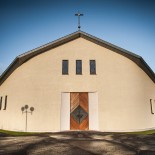In our parish, the people were intelligent direct cultivators who became expert nurserymen well known outside the district for the quality of their plants and produce. They mostly relied on fairs and markets in the surrounding market-towns, especially the Fair Hill of Ballymena, Kilrea, Maghera and Magherafelt. The houses were thatched, of one-storey and comfortable, heated with turf won from the moss by themselves in each season by the traditional methods. They had ample supplies of fowl, eggs, bacon from their own pigs, milk, butter, potatoes and vegetables, oats and flax. They could even distil their own poteen! They were self-sufficient for food and drink. They also had their own building materials near at hand with bricks from the Bann clays of Ballynease and Culbane and refractory clays for hearths, flues and drain-pipes as well as sand and lime.
Women shared the work on the land with the men and were able for many of the jobs to be done each season. They kept fowl, fed pigs, milked the cows, foddered the stock, churned cream and made butter, rickled turf and worked in the fields at planting and harvest time. Even the young girls of the household were able to help out in the chores. The women were also skilled weavers, knitters, embroiderers and excelled at lace and crochet work. There were spinning wheels in many homes (The spinning wheel of the Slammon family was said to have been preserved in Master Conway’s). The women got their raw materials (yarn) in McCleans of Knockloughrim. They gathered for the “flowering” ie. the making of bed quilts. They walked to Bellaghy by the “Weavers’ Path” which is a shortcut through Moneystaghan Moss out on to the main Bellaghy Road carrying their finished products for sale or exchange at “Manns” in Bellaghy (where the Police Barracks is now).
Many of the men got employment at the Peat Works and in extracting the clay used for refractory linings in the furnaces and kilns of England and Scotland. The clay was transported down the River Bann to Coleraine by lighter. The men also worked at the Drainage Schemes on the Clady River (1933) and on the River Bann (1936). Bricks were made at Ballynease and Culbane and many of the houses in the parish were built from Bann brick. The Ordnance Survey sappers remarked that the houses in this parish were very well constructed and superior in design and finish to the houses in neighbouring parishes. The mills provided another source of employment. There was a scutching mill and beetling mill at Innisrush and a corn mill at Glenburn. Most farmers grew flax. There was a subsidy of £10 per acre for flax during the Second World War. The saying was that flax was a vexatious crop from beginning to end. If it did well, you were annoyed that you hadn’t sown more; if badly, that you had grown it at all! As well as flax, the main crops were grass, corn, turnips, carrots, parsnips, leeks, cabbage, onions, parsley and lettuce. Probably the largest employer in the Parish was Teady McErlean Ltd, established in 1720. Which at one time owned a public house, drapers, grocery store, farm supplies and egg packing, timber yard and hardware store, plumbing supplies and furniture store, not forgetting the shirt factory which employed many women from the area.
But it was not all work. In the old days there used to be horse-racing at Greenlough. These races and sports lasted all the month of August. Every year there was a gathering at Mullaghnamoyagh for dancing and music and bonfires on Bealtaine or St John’s Eve. Mullaghnamoyagh is also known as “Den’s Hill” named after a local resident, Den or Denis McCloy. The old site at Mullaghnamoyagh has unfortunately been eroded by sand and gravel extraction which has reduced this ancient eminence to a fraction of its former extent.
A dominant feature of Den’s Hill is the monumental white standing cross commemorating the Holy Year of 1950. This was designed and executed by the late Harry Henry the well-known house-builder of Mullaghnamoyagh. In this work he was assisted by the McPeake Family – William, Henry, William Jr., Charles and the Henry Family – Edward, Arthur, Michael, Harry and Felix Gribben and Patrick Downey and Manus Marron. The Cross was unveiled by Arthur Henry and Henry McErlean who had been on Pilgrimage to Rome for the Holy Year. Fr Archie McMaster, P.P dedicated the Cross and led the recital of the Rosary and Mr John J. Conway, Schoolmaster made the dedicatory speech. The celebrations at Den’s Hill traditionally begin with the Rosary and on occasion Mass has been celebrated there in the open air. The Greenlough Pipe Band played suitable hymns for the occasion.
There were several bands in the district: Moneystaghan, Naville and Eden. They paraded to the “Demonstrations” or “ Big Days” of the Ancient Order of Hibernians on the 15th August, Feast of the Assumption and on St Patrick’s Day each year. But it was to the Moneystaghan band that the honour fell of parading with banners and and drums and bagpipes to Mass on these feast days and on other great parish occasions.
Hunting with dogs was a great pastime for the men and boys and they travelled to other areas with their hounds to hunt the fox, the rabbit and the hare. After the hunt, there was always a get-together and a celebration.






